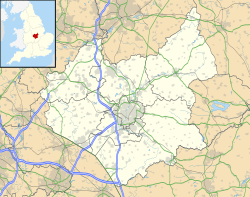Leicester Austin Friary facts for kids
| Monastery information | |
|---|---|
| Other names | The Augustinian Hermits of Leicester |
| Order | Austin Friars |
| Established | 1254 |
| Disestablished | 1538 |
| Dedicated to | St Catherine |
| Diocese | Lincoln |
| People | |
| Important associated figures | Thomas, 2nd Earl of Lancaster |
| Site | |
| Coordinates | 52°38′00″N 1°08′40″W / 52.633362°N 1.144428°W |
| Visible remains | None |
The Leicester Austin Friary was a special kind of religious house in Leicester, England. It belonged to a group of monks called the Austin Friars, also known as the Augustinian Hermits. Friaries were places where friars lived, prayed, and worked in the community.
History of the Friary
Starting the Friary
The Leicester Austin Friary began in the year 1254. It was dedicated to a saint named St Catherine. This means the friary was named in her honor.
Later, in 1304, a very important and powerful nobleman named Thomas, 2nd Earl of Lancaster helped to make the friary bigger. He added more buildings or land to it.
Key Moments
In 1372, something important happened at the friary. The main leaders of the Order of Austin Friars from all over met there. This meeting was called a "general chapter." It was a big event for the order.
Around the same time, in the late 1300s, a friar named Thomas Ratcliffe lived at the Leicester friary. He was known as a very good speaker and teacher. People thought he was a "renowned preacher."
The Friary's End
The Leicester Austin Friary closed down in November 1538. This was part of a big change in England called the English Reformation. During this time, many monasteries and friaries were closed by the king.
The friary was not very large when it closed. It was home to the Prior (the leader) and only three other friars. They owned just the land where the friary stood. They also had a few small properties in the town. The friary's yearly income was very small, only about £1. This was not much money, even back then.
Special Features
The Leicester Austin Friary was a bit unusual. Most friaries had one cloister. A cloister is a covered walkway, usually around a courtyard, where friars could walk and meditate. But this friary had two cloisters!


